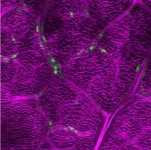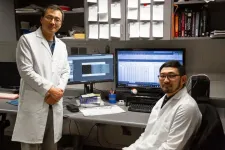(Press-News.org)
Ikoma, Japan—Throughout evolution, plants have continuously adapted to survive in changing environments. Apart from complex structural changes, plants have also developed various defense strategies against herbivores, including tougher protective layers, thorns, and chemical deterrents. Delving deeper into the evolution of defense mechanisms, a research team led by Assistant Professor Makoto Shirakawa from Nara Institute of Science and Technology (NAIST), identified a surprising genetic adaptation in the Brassicales plant order. In these cruciferous plants—including cabbage, mustard, and wasabi—genes originally used for gas exchange have been repurposed for defense.
The researchers uncovered the unique mechanism behind this evolutionary adaptation. Their findings were published online on February 24, 2025 and published in Volume 11 of the journal Nature Plants on March 01, 2025. The research team included Tomoki Oguro, Nobutoshi Yamaguchi, and Toshiro Ito from NAIST; Shigeo S. Sugano from National Institute of Advanced Industrial Science and Technology; Shohei Yamaoka and Takayuki Kohchi from Kyoto University; Yasunori Ichihashi from RIKEN Institute; Atsushi Takemiya from Yamaguchi University; and Takamasa Suzuki from Chubu University.
According to the study, FAMA, a protein primarily responsible for regulating gene expression for gas exchange, serves a dual role for the cruciferous plants. Beyond controlling stomatal (tiny pores for gas exchange) guard cells, FAMA also helps to produce myrosin cells—the specialized structures that store mustard oil compounds. So, when a plant is damaged, these compounds create a sharp, pungent taste that repels herbivores.
“We identified a specific gene called WASABI MAKER (WSB), which is directly activated by FAMA and is the key trigger for the development of myrosin cells,” shares Dr. Shirakawa. “When we studied the plants without WSB, we found that these defense cells failed to form, confirming its essential role in myrosin cell production.”
Additionally, the researchers identified another gene called STOMATAL CARPENTER 1 (SCAP1), which is also a target for FAMA. This gene collaborates with WSB in regulating guard cell development, but its role in myrosin cell formation appears to be secondary.
Evolutionary analysis suggests that these genetic pathways originally helped regulate stomatal development but were later repurposed for defense in Brassicales. “This discovery is particularly interesting because it highlights how gene repurposing allows plants to develop new survival strategies without evolving entirely new genes,” adds co-author Toshiro Ito.
This remarkable discovery offers promising avenues for improving crop yield. Modifying key genetic regulators like FAMA could help enhance the chemical defense in crops and vegetables, avoiding pest damage. Additionally, since FAMA also controls gas exchange, it can be optimized for efficient uptake of carbon dioxide in plants.
Moving forward, the researchers aim to uncover the mechanism of how plants have evolved to produce such a diverse range of specialized cells. Highlighting the significance of their research, Dr. Shirakawa concludes, “Beyond offering new insights for crop improvement strategies, we believe our future work will help answer one of biology’s most fundamental questions: How have plants achieved such remarkable diversity with a limited number of genes?”
###
Resource
Title: Co-option and neofunctionalization of stomatal executors for defence against herbivores in Brassicales
Authors: Makoto Shirakawa, Tomoki Oguro, Shigeo S. Sugano, Shohei Yamaoka, Mayu Sagara, Mai Tanida, Kyoko Sunuma, Takuya Iwami, Tatsuyoshi Nakanishi, Keita Horiuchi, Kie Kumaishi, Soma Yoshida, Mutsumi Watanabe, Takayuki Tohge, Takamasa Suzuki, Yasunori Ichihashi, Atsushi Takemiya, Nobutoshi Yamaguchi, Takayuki Kohchi, and Toshiro Ito
Journal: Nature plants
DOI: 10.1038/s41477-025-01921-1
Information about the Plant Stem Cell Regulation and Floral Patterning Laboratory can be found at the following website: https://bsw3.naist.jp/ito/
About Professor Makoto Shirakawa from Nara Institute of Science and Technology, Japan
Dr. Makoto Shirakawa is an Assistant Professor at Nara Institute of Science and Technology (NAIST) in Ikoma, Japan. He earned his PhD from Kyoto University, Japan, and specializes in plant biology, molecular biology, cell biology, genome editing, and botany. His key research includes CRISPR/Cas9 applications in Marchantia polymorpha, studies on Arabidopsis thaliana, and plant development. For his remarkable contributions, he is recognized among Japan's top scientists in plant cell and developmental biology.
About Nara Institute of Science and Technology (NAIST)
Established in 1991, Nara Institute of Science and Technology (NAIST) is a national university located in Kansai Science City, Japan. In 2018, NAIST underwent an organizational transformation to promote and continue interdisciplinary research in the fields of biological sciences, materials science, and information science. Known as one of the most prestigious research institutions in Japan, NAIST lays a strong emphasis on integrated research and collaborative co-creation with diverse stakeholders. NAIST envisions conducting cutting-edge research in frontier areas and training students to become tomorrow's leaders in science and technology.
Website: https://www.naist.jp/en/
END
New York, NY — The American Federation for Aging Research (AFAR), is pleased to announce the 2025 recipients of three of its annual Scientific Awards of Distinction: David B. Allison, PhD, will receive the Irving S. Wright Award of Distinction; Daniel W. Belsky, PhD, will receive the Vincent Cristofalo Rising Star Award in Aging Research; and Arlan Richardson, PhD, will receive the George M. Martin Lifetime Achievement in Mentoring Award.
The Irving S. Wright Award of Distinction is named in honor of AFAR’s founder and recognizes exceptional contributions to basic ...
RIVERSIDE, Calif. -- Vaping during pregnancy is becoming more common, but its impact on early human development is not well understood. A new study by scientists at the University of California, Riverside, now reports that the flavor chemical menthol used in electronic cigarettes could pose risks to a developing baby.
The study, published in STEM CELLS Translational Medicine, used human embryonic stem cells, or hESCs, to characterize early stages of embryonic development and examined how low concentrations of menthol affect important cellular processes.
The ...
Clothes that can mimic the feeling of being touched, touch displays that provide haptic feedback to users, or even ultralight loudspeakers. These are just some of the devices made possible using thin silicone films that can be precisely controlled so that they vibrate, flex, press or pull exactly as desired. And all done simply by applying an electrical voltage. The research teams at the Center for Mechatronics and Automation Technology in Saarbrücken (ZeMA) headed by Professors Stefan Seelecke and Paul Motzki (Saarland University) and John Heppe (htw saar – University of Applied Sciences ...
FAMU-FSU College of Engineering researchers have created a new method for studying protein degradation within immune cells that uses engineered microparticles to track and analyze degradation processes more effectively than traditional methods.
The work, which was published in ACS Applied Materials & Interfaces, has important implications for treating diseases such as cancer, Alzheimer’s disease and autoimmune disorders.
“There is a lot we still don’t know about how cells ingest and eliminate tissue debris or pathogens — the process ...
How gravity causes a perfectly spherical ball to roll down an inclined plane is part of elementary school physics canon. But the world is messier than a textbook.
Scientists in the Harvard John A. Paulson School of Engineering and Applied Sciences (SEAS) have sought to quantitatively describe the much more complex rolling physics of real-world objects. Led by L. Mahadevan, the Lola England de Valpine Professor of Applied Mathematics, Physics, and Organismic and Evolutionary Biology in SEAS and FAS, they combined theory, simulations, and experiments to understand what happens when an imperfect, ...
A team of researchers from Arizona State University, the U.S. Army Research Laboratory (ARL), Lehigh University and Louisiana State University has developed a groundbreaking high-temperature copper alloy with exceptional thermal stability and mechanical strength.
The research team’s findings on the new copper alloy, published in prestigious journal Science, introduce a novel bulk Cu-3Ta-0.5Li nanocrystalline alloy that exhibits remarkable resistance to coarsening and creep deformation, even at temperatures near its melting point.
“Our alloy design approach mimics the strengthening mechanisms found in Ni-based superalloys,” said Kiran Solanki, a professor at ...
The way teachers manage classroom discussion with pupils plays a key role in the teaching of writing, a new study shows.
The research shows the importance of managing classroom discussion in a way that develops pupils’ understanding of the choices that writers make, and how those choices create particular effects for readers. This discussion helps pupils to think more about the choices that they make in their own writing.
The study reinforces the importance of dedicating time to discussion in secondary English lessons. It shows that time should be given to exploratory, speculative discussion that ...
Research from Stanley Manne Children’s Research Institute at Ann & Robert H. Lurie Children’s Hospital of Chicago strongly suggests that Kawasaki disease is caused by a single respiratory virus that is yet to be identified. Findings contradict the theory that many different pathogens or toxins could cause this disease that can lead to serious cardiac complications in young children.
“The cause of Kawasaki disease has been a mystery for over 50 years,” said Anne Rowley, MD, pediatric infectious diseases expert and scientist at Manne Research Institute at Lurie Children’s, who is the lead author on the study published ...
In brief
Surface waters in the Southern Ocean have been cooling in recent decades, counter to what climate models predict.
Scientists have quantified how much of the cooling observed since 1990 has been driven by an influx of freshwater that’s unaccounted for in state-of-the-art climate models.
The researchers discovered that freshwater inputs along the coast from melting ice sheets exert surprisingly strong influence on Southern Ocean surface temperatures and the broader climate system.
Global climate models predict that the ocean around Antarctica ...
Atrial fibrillation (AF) is a common form of heart arrhythmia, a serious condition in which the heart beats so fast that its upper chambers, the atria, quiver. This irregular heartbeat can increase the risk of severe conditions, including heart failure, dementia and stroke.
“My lab has been studying the role of inflammation in the initiation and persistence of AF for many years. In this multidisciplinary study, we investigated the function of gasdermin D, a key participant in inflammatory pathways, in atrial heart cells and its potential contribution to AF,” said corresponding author Dr. Na Li, professor of medicine ...




